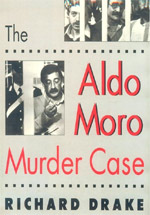The Aldo Moro murder case
Edito da Harvard University Press, Cambridge, 1995
318 pagine
di Richard Drake
Libro presente nelle categorie:
 Quarta di copertina
Quarta di copertinaAldo Moro's kidnapping and violent death in 1978 shocked Italy as no other event has during the entire history of the Republic. It had much the same effect in Italy as the assassination of President John F. Kennedy had in the United States, with both cases giving rise to endless conspiracy theories. The dominant Christian Democratic leader for twenty years, Moro had embodied the country's peculiar religious politics, its values as well as its practices. He was perceived as the most exemplary representative of the Catholic political tradition in Italy. The Red Brigades who killed him thought that in striking Moro they would cause the collapse of the capitalist establishment and clear the way for a Marxist-Leninist revolution.
In his thorough account of the long and anguished quest for justice in the Moro murder case, Richard Drake provides a detailed portrait of the tragedy and its aftermath as complex symbols of a turbulent age in Italian history. Since Moro's murder, documents from two parliamentary inquiries and four sets of trials explain the historical and political process and illuminate two enduring themes in Italian history. First, the records contain a wealth of examples bearing on the nation's longstanding culture of ideological extremism and violence. Second, Moro's story reveals much about the inner workings of democracy Italian style, including the roles of the United States and the Mafia. These insights are especially valuable today in understanding why the Italian establishment is in a state of collapse.
The Moro case also explores the worldwide problem of terrorism. In great detail, the case reveals the mentality, the tactics, and the strategy of the Red Brigades and related groups. Moro's fate has a universal poignancy, with aspects of a classical Greek tragedy. Drake provides a full historical account of how the Italian people have come to terms with this tragedy.
Sullo stesso argomento
Articoli in archivio
Giornata della memoria, il Quirinale include Giorgiana Masi
Vittime del terrorismo, la lista del Colle
Per la prima volta si celebrano tutti i caduti degli anni di piombo. Il ricordo in un volume
Vittime del terrorismo, la lista del Colle
Per la prima volta si celebrano tutti i caduti degli anni di piombo. Il ricordo in un volume
di Giovanni Bianconi su Corriere della Sera del 09/05/2008
L’anniversario di via Fani Veltroni: chi ha sparato dovrebbe evitare di riempire giornali e tv
«Ho perdonato, incontrerei Moretti»
Parla Agnese, figlia di Aldo Moro, 30 anni dopo il rapimento. Cossiga s’inginocchia
«Ho perdonato, incontrerei Moretti»
Parla Agnese, figlia di Aldo Moro, 30 anni dopo il rapimento. Cossiga s’inginocchia
di Virginia Piccolillo su Corriere della Sera del 17/03/2008
di Francesco Grignetti su La Stampa del 09/03/2008
News in archivio
In biblioteca
di Marco Monetta
Prospettiva Editrice, 2009
Prospettiva Editrice, 2009





